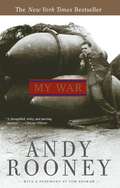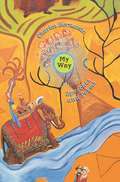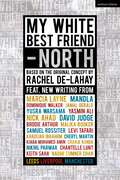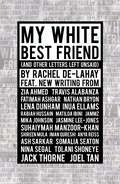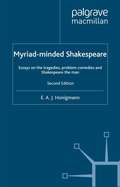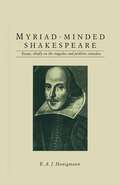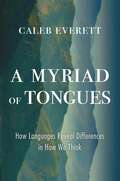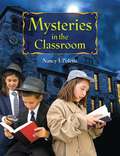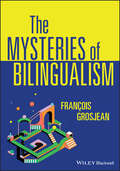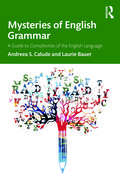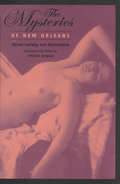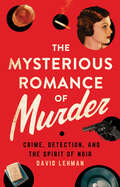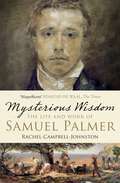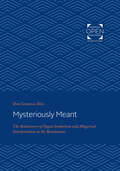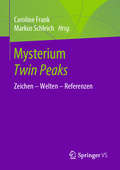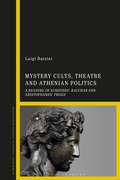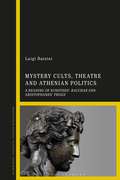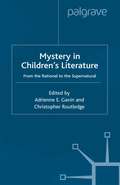- Table View
- List View
My War (Thorndike Press Large Print Nonfiction Ser.)
by Andy RooneyMy War is a blunt, funny, idiosyncratic account of Andy Rooney's World War II. As a young, naïve correspondent for The Stars and Stripes, Rooney flew bomber missions, arrived in France during the D-Day invasion, crossed the Rhine with the Allied forces, traveled to Paris for the Liberation, and was one of the first reporters into Buchenwald. Like so many of his generation, Rooney's life was changed forever by the war. He saw life at the extremes of human experience, and wrote about what he observed, making it real to millions of men and women. My War is the story of an inexperienced kid learning the craft of journalism. It is by turns moving, suspenseful, and reflective. And Rooney's unmistakable voice shines through on every page.
My War
by Andy RooneyMy War is a blunt, funny, idiosyncratic account of Andy Rooney's World War II. As a young, naïve correspondent for The Stars and Stripes, Rooney flew bomber missions, arrived in France during the D-Day invasion, crossed the Rhine with the Allied forces, traveled to Paris for the Liberation, and was one of the first reporters into Buchenwald. Like so many of his generation, Rooney's life was changed forever by the war. He saw life at the extremes of human experience, and wrote about what he observed, making it real to millions of men and women. My War is the story of an inexperienced kid learning the craft of journalism. It is by turns moving, suspenseful, and reflective. And Rooney's unmistakable voice shines through on every page.
My Way: Speeches and Poems
by Charles Bernstein"Verse is born free but everywhere in chains. It has been my project to rattle the chains." (from "The Revenge of the Poet-Critic") In My Way, (in)famous language poet and critic Charles Bernstein deploys a wide variety of interlinked forms—speeches and poems, interviews and essays—to explore the place of poetry in American culture and in the university. Sometimes comic, sometimes dark, Bernstein's writing is irreverent but always relevant, "not structurally challenged, but structurally challenging." Addressing many interrelated issues, Bernstein moves from the role of the public intellectual to the poetics of scholarly prose, from vernacular modernism to idiosyncratic postmodernism, from identity politics to the resurgence of the aesthetic, from cultural studies to poetry as a performance art, from the small press movement to the Web. Along the way he provides "close listening" to such poets as Charles Reznikoff, Laura Riding, Susan Howe, Ezra Pound, Allen Ginsberg, and Gertrude Stein, as well as a fresh perspective on L=A=N=G=U=A=G=E, the magazine he coedited that became a fulcrum for a new wave of North American writing. In his passionate defense of an activist, innovative poetry, Bernstein never departs from the culturally engaged, linguistically complex, yet often very funny writing that has characterized his unique approach to poetry for over twenty years. Offering some of his most daring work yet—essays in poetic lines, prose with poetic motifs, interviews miming speech, speeches veering into song—Charles Bernstein's My Way illuminates the newest developments in contemporary poetry with its own contributions to them. "The result of [Bernstein's] provocative groping is more stimulating than many books of either poetry or criticism have been in recent years."—Molly McQuade, Washington Post Book World "This book, for all of its centrifugal activity, is a singular yet globally relevant perspective on the literary arts and their institutions, offered in good faith, yet cranky and poignant enough to not be easily ignored."—Publishers Weekly "Bernstein has emerged as postmodern poetry's sous-chef of insouciance. My Way is another of his rich concoctions, fortified with intellect and seasoned with laughter."—Timothy Gray, American Literature
My Way: Speeches and Poems
by Charles Bernstein"Verse is born free but everywhere in chains. It has been my project to rattle the chains." (from "The Revenge of the Poet-Critic") In My Way, (in)famous language poet and critic Charles Bernstein deploys a wide variety of interlinked forms—speeches and poems, interviews and essays—to explore the place of poetry in American culture and in the university. Sometimes comic, sometimes dark, Bernstein's writing is irreverent but always relevant, "not structurally challenged, but structurally challenging." Addressing many interrelated issues, Bernstein moves from the role of the public intellectual to the poetics of scholarly prose, from vernacular modernism to idiosyncratic postmodernism, from identity politics to the resurgence of the aesthetic, from cultural studies to poetry as a performance art, from the small press movement to the Web. Along the way he provides "close listening" to such poets as Charles Reznikoff, Laura Riding, Susan Howe, Ezra Pound, Allen Ginsberg, and Gertrude Stein, as well as a fresh perspective on L=A=N=G=U=A=G=E, the magazine he coedited that became a fulcrum for a new wave of North American writing. In his passionate defense of an activist, innovative poetry, Bernstein never departs from the culturally engaged, linguistically complex, yet often very funny writing that has characterized his unique approach to poetry for over twenty years. Offering some of his most daring work yet—essays in poetic lines, prose with poetic motifs, interviews miming speech, speeches veering into song—Charles Bernstein's My Way illuminates the newest developments in contemporary poetry with its own contributions to them. "The result of [Bernstein's] provocative groping is more stimulating than many books of either poetry or criticism have been in recent years."—Molly McQuade, Washington Post Book World "This book, for all of its centrifugal activity, is a singular yet globally relevant perspective on the literary arts and their institutions, offered in good faith, yet cranky and poignant enough to not be easily ignored."—Publishers Weekly "Bernstein has emerged as postmodern poetry's sous-chef of insouciance. My Way is another of his rich concoctions, fortified with intellect and seasoned with laughter."—Timothy Gray, American Literature
My Way: Speeches and Poems
by Charles Bernstein"Verse is born free but everywhere in chains. It has been my project to rattle the chains." (from "The Revenge of the Poet-Critic") In My Way, (in)famous language poet and critic Charles Bernstein deploys a wide variety of interlinked forms—speeches and poems, interviews and essays—to explore the place of poetry in American culture and in the university. Sometimes comic, sometimes dark, Bernstein's writing is irreverent but always relevant, "not structurally challenged, but structurally challenging." Addressing many interrelated issues, Bernstein moves from the role of the public intellectual to the poetics of scholarly prose, from vernacular modernism to idiosyncratic postmodernism, from identity politics to the resurgence of the aesthetic, from cultural studies to poetry as a performance art, from the small press movement to the Web. Along the way he provides "close listening" to such poets as Charles Reznikoff, Laura Riding, Susan Howe, Ezra Pound, Allen Ginsberg, and Gertrude Stein, as well as a fresh perspective on L=A=N=G=U=A=G=E, the magazine he coedited that became a fulcrum for a new wave of North American writing. In his passionate defense of an activist, innovative poetry, Bernstein never departs from the culturally engaged, linguistically complex, yet often very funny writing that has characterized his unique approach to poetry for over twenty years. Offering some of his most daring work yet—essays in poetic lines, prose with poetic motifs, interviews miming speech, speeches veering into song—Charles Bernstein's My Way illuminates the newest developments in contemporary poetry with its own contributions to them. "The result of [Bernstein's] provocative groping is more stimulating than many books of either poetry or criticism have been in recent years."—Molly McQuade, Washington Post Book World "This book, for all of its centrifugal activity, is a singular yet globally relevant perspective on the literary arts and their institutions, offered in good faith, yet cranky and poignant enough to not be easily ignored."—Publishers Weekly "Bernstein has emerged as postmodern poetry's sous-chef of insouciance. My Way is another of his rich concoctions, fortified with intellect and seasoned with laughter."—Timothy Gray, American Literature
My White Best Friend: Volume 2: North
by Bloomsbury PublishingWhat's the one thing that you need to say but have never dared? And who needs to hear it?Based on the original concept by playwright Rachel De-Lahay, this follow-up volume to My White Best Friend (And Other Letters Left Unsaid) collects a series of personal letters, monologues and writings by 20 Black and ethnically diverse writers from across the North of England. Sometimes funny, sometimes poignant, sometimes political and full of fire, these letters explore the personal and political of the things we don't dare say – even to those closest to us.Originally commissioned by Everyman & Playhouse theatres, Eclipse and the Royal Exchange in 2021, in response to The Bunker Theatre's critically acclaimed 2019 festival, this volume contains a foreword by Rachel De-Lahay, creator of the project and editor of the first volume, as well as writings from some of the most exciting voices in the North of England: Levi Tafari, Brodie Arthur, Kiara Mohamed Amin, Yasmin Ali, Chantelle Lunt, Dominique Walker, Keith Saha, Samuel Rossiter, Cheryl Martin, Nikhil Parmar, mandla rae, David Judge, Yusra Warsama, Nick Ahad, Malika Booker, Jamal Gerald, Khadijah Ibrahiim, Chanje Kunda, Marcia Layne and Naomi Sumner Chan.
My White Best Friend: Volume 2: North
by Bloomsbury PublishingWhat's the one thing that you need to say but have never dared? And who needs to hear it?Based on the original concept by playwright Rachel De-Lahay, this follow-up volume to My White Best Friend (And Other Letters Left Unsaid) collects a series of personal letters, monologues and writings by 20 Black and ethnically diverse writers from across the North of England. Sometimes funny, sometimes poignant, sometimes political and full of fire, these letters explore the personal and political of the things we don't dare say – even to those closest to us.Originally commissioned by Everyman & Playhouse theatres, Eclipse and the Royal Exchange in 2021, in response to The Bunker Theatre's critically acclaimed 2019 festival, this volume contains a foreword by Rachel De-Lahay, creator of the project and editor of the first volume, as well as writings from some of the most exciting voices in the North of England: Levi Tafari, Brodie Arthur, Kiara Mohamed Amin, Yasmin Ali, Chantelle Lunt, Dominique Walker, Keith Saha, Samuel Rossiter, Cheryl Martin, Nikhil Parmar, mandla rae, David Judge, Yusra Warsama, Nick Ahad, Malika Booker, Jamal Gerald, Khadijah Ibrahiim, Chanje Kunda, Marcia Layne and Naomi Sumner Chan.
My White Best Friend: (And Other Letters Left Unsaid)
“Could you put your white best friend on stage and remind them that they're part of the problem? Even if you love them? Even if you never want anyone to feel for even a moment how you feel living in this world every day? Would - could - a white person finally hear what you have to say?”Originally commissioned by The Bunker Theatre as a critically-acclaimed festival that ran in 2019, My White Best Friend collects 23 letters that engage with a range of topics, from racial tensions, microaggressions and emotional labour, to queer desire, prejudice and otherness. Expressing feelings and thoughts often stifled or ignored, the pieces here transform letter writing into a provocative act of candour.Funny, heartfelt, wry and heart-breaking, whether a letter to their younger self or an ode to the writer's tongue, this anthology of exceptional writing is always engaging and thought-provoking.Featuring different letters from some of the most exciting voices in the UK and beyond, My White Best Friend (And Other Letters Left Unsaid) includes work from: Zia Ahmed, Travis Alabanza, Fatimah Asghar, Nathan Bryon, Matilda Ibini, Jammz, Iman Qureshi, Anya Reiss, Somalia Seaton, Nina Segal, Tolani Shoneye, Lena Dunham, Inua Ellams, Rabiah Hussain, Mika Johnson, Jasmine Lee-Jones, Suhaiymah Manzoor-Khan, Shireen Mula, Ash Sarkar, Jack Thorne and Joel Tan.
Myriad-minded Shakespeare: Essays on the Tragedies, the Problem Plays and Shakespeare the Man
by E. HonigmannMyriad-minded Shakespeare introduces readers to the great variety of approaches to Shakespeare. The political and sexist implications of the plays, their sources, staging issues, textual disputes and the dramatist's character and biography are all analysed here, bringing out the interconnectedness of critical questions. Ernst Honigmann plunges straight into his subjects and shows that it is rarely safe to seek solutions that are narrowly exclusive. For the second edition a new preface places the essays in the context of recent critical debate and a new chapter on Shakespeare's will provides a fascinating insight into Shakespeare's independent spirit.
Myriad-minded Shakespeare: Essays, chiefly on the tragedies and problem comedies (Contemporary Interpretations Of Shakespeare Ser.)
by E.A.J. HonigmannA Myriad of Tongues: How Languages Reveal Differences in How We Think
by Caleb EverettA sweeping exploration of the relationship between the language we speak and our perception of such fundamentals of experience as time, space, color, and smells.We tend to assume that all languages categorize ideas and objects similarly, reflecting our common human experience. But this isn’t the case. When we look closely, we find that many basic concepts are not universal, and that speakers of different languages literally see and think about the world differently.Caleb Everett takes readers around the globe, explaining what linguistic diversity tells us about human culture, overturning conventional wisdom along the way. For instance, though it may seem that everybody refers to time in spatial terms—in English, for example, we speak of time “passing us by”—speakers of the Amazonian language Tupi Kawahib never do. In fact, Tupi Kawahib has no word for “time” at all. And while it has long been understood that languages categorize colors based on those that speakers regularly encounter, evidence suggests that the color words we have at our disposal affect how we discriminate colors themselves: a rose may not appear as rosy by any other name. What’s more, the terms available to us even determine the range of smells we can identify. European languages tend to have just a few abstract odor words, like “floral” or “stinky,” whereas Indigenous languages often have well over a dozen.Why do some cultures talk anthropocentrically about things being to one’s “left” or “right,” while others use geocentric words like “east” and “west”? What is the connection between what we eat and the sounds we make? A Myriad of Tongues answers these and other questions, yielding profound insights into the fundamentals of human communication and experience.
Mysteries in the Classroom
by Nancy J. PoletteCelebrated author Nancy Polette offers a complete mystery literature guide for primary, intermediate, and middle school mysteries.Librarians and teachers alike will find this engaging title from popular author Nancy Polette a joy to use, and the information it offers is a sure way to engage students in literature. Mysteries in the Classroom introduces 23 reading strategies tied to the National Standards in Reading, Language Arts, and Social Studies that can be used with any mystery.Booktalks and activities are presented for 17 favorite mystery series and 6 favorite authors. The book includes hands-on activities to introduce each series and author, booktalks for the Edgar Allan Poe Juvenile Mystery Award winners from 1979 to 2008, and step-by-step directions for turning booktalks into readers theatre presentations. An especially exciting feature is a section contributed by Newberry-award winning author Richard Peck in which he guides budding young writers in coauthoring a mystery with him.Grades 1-6
The Mysteries of Bilingualism: Unresolved Issues
by François GrosjeanEleven critical issues in the study of bilingualism: Insightful analyses by renowned expert François Grosjean The majority of people living around the world today are able to speak more than one language, yet many aspects of the nature and experience of bilingualism raise unresolved questions for researchers. Who exactly is bilingual? What is the extent of bilingualism? How do infant bilinguals who acquire two languages at the same time manage to separate them? Does language processing work differently when bilinguals are interacting with monolinguals and with bilinguals? When a speaker changes their language, do they also change aspects of their personality? In The Mysteries of Bilingualism, eminent scholar François Grosjean provides a comprehensive examination of individual bilingualism that delves into unanswered questions and challenges many of the myths and misconceptions surrounding bilingualism. Through insightful analyses of eleven key questions, this book offers a unique combination of personal reflection, literature review, personal testimony, and case studies to explore these mysteries. Altogether, this text offers: Comprehensive explorations of the linguistic aspects of bilingualism, including who is bilingual, describing bilinguals, accented speech, and language loss Practical discussions of speech and language processing, including language choice and mixed speech perception and production In-depth examinations of personality and culture in relation to bilingualism and biculturalism Perfect for undergraduate and graduate students of bilingualism, multilingualism, second language acquisition, and applied linguistics, The Mysteries of Bilingualism offers an up-to-date view of the leading research questions in the study of bilingualism today.
The Mysteries of Bilingualism: Unresolved Issues
by François GrosjeanEleven critical issues in the study of bilingualism: Insightful analyses by renowned expert François Grosjean The majority of people living around the world today are able to speak more than one language, yet many aspects of the nature and experience of bilingualism raise unresolved questions for researchers. Who exactly is bilingual? What is the extent of bilingualism? How do infant bilinguals who acquire two languages at the same time manage to separate them? Does language processing work differently when bilinguals are interacting with monolinguals and with bilinguals? When a speaker changes their language, do they also change aspects of their personality? In The Mysteries of Bilingualism, eminent scholar François Grosjean provides a comprehensive examination of individual bilingualism that delves into unanswered questions and challenges many of the myths and misconceptions surrounding bilingualism. Through insightful analyses of eleven key questions, this book offers a unique combination of personal reflection, literature review, personal testimony, and case studies to explore these mysteries. Altogether, this text offers: Comprehensive explorations of the linguistic aspects of bilingualism, including who is bilingual, describing bilinguals, accented speech, and language loss Practical discussions of speech and language processing, including language choice and mixed speech perception and production In-depth examinations of personality and culture in relation to bilingualism and biculturalism Perfect for undergraduate and graduate students of bilingualism, multilingualism, second language acquisition, and applied linguistics, The Mysteries of Bilingualism offers an up-to-date view of the leading research questions in the study of bilingualism today.
Mysteries of English Grammar: A Guide to Complexities of the English Language
by Andreea S. Calude Laurie BauerDespite a history of hundreds of years of research analysing aspects of English grammar, there are still open problems which continue to baffle language researchers today. Such ‘grammar mysteries’ arise for a number of reasons: because the language is changing; because different speakers of the language adhere to distinct norms and thus introduce and maintain variation in the system; because there are differences between the grammar of spoken and written English. This book illuminates some of the complexities of the subject, the areas where new discoveries await and why it matters. Through a series of accessible and engaging case studies on various aspects of grammar, from multiple negation to possession, the authors present grammar as an intellectual challenge. This book brings out into the open questions about language usage to which we still do not have good answers in a bid to make variation overt and to revel in the mystery of the English language. Both aimed at the interested general reader and the beginning student of English language and linguistics, this is a fresh take on grammar.
Mysteries of English Grammar: A Guide to Complexities of the English Language
by Andreea S. Calude Laurie BauerDespite a history of hundreds of years of research analysing aspects of English grammar, there are still open problems which continue to baffle language researchers today. Such ‘grammar mysteries’ arise for a number of reasons: because the language is changing; because different speakers of the language adhere to distinct norms and thus introduce and maintain variation in the system; because there are differences between the grammar of spoken and written English. This book illuminates some of the complexities of the subject, the areas where new discoveries await and why it matters. Through a series of accessible and engaging case studies on various aspects of grammar, from multiple negation to possession, the authors present grammar as an intellectual challenge. This book brings out into the open questions about language usage to which we still do not have good answers in a bid to make variation overt and to revel in the mystery of the English language. Both aimed at the interested general reader and the beginning student of English language and linguistics, this is a fresh take on grammar.
The Mysteries of New Orleans (The Longfellow Series of American Languages and Literatures)
by Baron Ludwig von Reizenstein"Reizenstein's peculiar vision of New Orleans is worth resurrecting precisely because it crossed the boundaries of acceptable taste in nineteenth-century German America and squatted firmly on the other side... This work makes us realize how limited our notions were of what could be conceived by a fertile American imagination in the middle of the nineteenth century."—from the Introduction by Steven RowanA lost classic of America's neglected German-language literary tradition, The Mysteries of New Orleans by Baron Ludwig von Reizenstein first appeared as a serial in the Louisiana Staats-Zeitung, a New Orleans German-language newspaper, between 1854 and 1855. Inspired by the gothic "urban mysteries" serialized in France and Germany during this period, Reizenstein crafted a daring occult novel that stages a frontal assault on the ethos of the antebellum South. His plot imagines the coming of a bloody, retributive justice at the hands of Hiram the Freemason—a nightmarish, 200-year-old, proto-Nietzschean superman—for the sin of slavery. Heralded by the birth of a black messiah, the son of a mulatto prostitute and a decadent German aristocrat, this coming revolution is depicted in frankly apocalyptic terms.Yet, Reizenstein was equally concerned with setting and characters, from the mundane to the fantastic. The book is saturated with the atmosphere of nineteenth-century New Orleans, the amorous exploits of its main characters uncannily resembling those of New Orleans' leading citizens. Also of note is the author's progressively matter-of-fact portrait of the lesbian romance between his novel's only sympathetic characters, Claudine and Orleana. This edition marks the first time that The Mysteries of New Orleans has been translated into English and proves that 150 years later, this vast, strange, and important novel remains as compelling as ever.
The Mysterious Romance of Murder: Crime, Detection, and the Spirit of Noir
by David LehmanFrom Sherlock Holmes to Sam Spade; Nick and Nora Charles to Nero Wolfe and Archie Goodwin; Harry Lime to Gilda, Madeleine Elster, and other femmes fatales—crime and crime solving in fiction and film captivate us. Why do we keep returning to Agatha Christie's ingenious puzzles and Raymond Chandler's hard-boiled murder mysteries? What do spy thrillers teach us, and what accounts for the renewed popularity of morally ambiguous noirs? In The Mysterious Romance of Murder, the poet and critic David Lehman explores a wide variety of outstanding books and movies—some famous (The Maltese Falcon, Double Indemnity), some known mainly to aficionados—with style, wit, and passion.Lehman revisits the smoke-filled jazz clubs from the classic noir films of the 1940s, the iconic set pieces that defined Hitchcock's America, the interwar intrigue of Eric Ambler's best fictions, and the intensity of attraction between Humphrey Bogart and Lauren Bacall, Robert Mitchum and Jane Greer, Cary Grant and Ingrid Bergman. He also considers the evocative elements of noir—cigarettes, cocktails, wisecracks, and jazz standards—and offers five original noir poems (including a pantoum inspired by the 1944 film Laura) and ironic astrological profiles of Barbara Stanwyck, Marlene Dietrich, and Graham Greene. Written by a connoisseur with an uncanny feel for the language and mood of mystery, espionage, and noir, The Mysterious Romance of Murder will delight fans of the genre and newcomers alike.
Mysterious Wisdom: The Life and Work of Samuel Palmer
by Rachel Campbell-JohnstonA devotee of the great visionary William Blake, Samuel Palmer became the lynchpin of the first British art movement. Leading a band of fellow artists - the brotherhood of Ancients - out of London to the village of Shoreham in Kent, he set out to create a new rural ideal. His paintings of slumbering shepherds and tumbling blossoms, of mystical cornfields and bright sickle moons, capture a world in which landscape and politics, religion and culture all meet. They reflect the concerns of the nineteenth century which his life spanned. In his day, like his mentor Blake, Samuel Palmer was much neglected. He did not attempt the grand dramas of J.M.W. Turner or follow John Constable's profoundly naturalistic path. But he belongs in their pantheon of great British Romantics as much for the numinous visions that are embodied in his loveliest paintings as for the vagaries of a life story in which he so often failed. If English tradition had ever encompassed the making of icons they would not have been so different from Palmer's enchanted landscapes. Mysterious Wisdom offers for the first time in more than thirty-five years a vivid and intimate portrait of Palmer who, over the course of the past century, has become increasingly treasured as one of the most extraordinarily talented and quirkily eccentric figures of the British art world, or - as the art historian Kenneth Clark believed - an English Van Gogh.
Mysteriously Meant: The Rediscovery of Pagan Symbolism and Allegorical Interpretation in the Renaissance
by Don Cameron AllenOriginally published in 1971. In Mysteriously Meant, Professor Allen maps the intellectual landscape of the Renaissance as he explains the discovery of an allegorical interpretation of Greek, Latin, and finally Egyptian myths and the effect this discovery had on the development of modern attitudes toward myth. He believes that to understand Renaissance literature one must understand the interpretations of classical myth known to the sixteenth and seventeenth centuries. In unraveling the elusive strands of myth, allegory, and symbol from the fabric of Renaissance literature such as Milton's Paradise Lost, Allen is a helpful guide. His discussion of Renaissance authors is as authoritative as it is inclusive. His empathy with the scholars of the Renaissance keeps his discussion lively—a witty study of interpreters of mythography from the past.
Mysteriously Meant: The Rediscovery of Pagan Symbolism and Allegorical Interpretation in the Renaissance
by Don Cameron AllenOriginally published in 1971. In Mysteriously Meant, Professor Allen maps the intellectual landscape of the Renaissance as he explains the discovery of an allegorical interpretation of Greek, Latin, and finally Egyptian myths and the effect this discovery had on the development of modern attitudes toward myth. He believes that to understand Renaissance literature one must understand the interpretations of classical myth known to the sixteenth and seventeenth centuries. In unraveling the elusive strands of myth, allegory, and symbol from the fabric of Renaissance literature such as Milton's Paradise Lost, Allen is a helpful guide. His discussion of Renaissance authors is as authoritative as it is inclusive. His empathy with the scholars of the Renaissance keeps his discussion lively—a witty study of interpreters of mythography from the past.
Mysterium Twin Peaks: Zeichen – Welten – Referenzen
by Caroline Frank Markus SchleichDer Sammelband bringt verschiedene Zugänge und Kontexte zu Twin Peaks zusammen und greift dabei auch die besonderen produktions- und rezeptionsästhetischen Spezifika der Serie auf. Das Spektrum der Beiträge umfasst ganz unterschiedliche Themenbereiche: Genremix, Transaktualität, komplexe narrative Strukturen, Traum und Traumhaftigkeit, Geschlechts- und Identitätskonzepte, extremer Fankult, visuelle Ästhetik, akustische Dimensionen, postmoderne Verweiskultur und nicht zuletzt die Frage danach, welche anderen Quality TV-Serien durch Twin Peaks erst möglich wurden.
Mystery Cults, Theatre and Athenian Politics: A Reading of Euripides' Bacchae and Aristophanes' Frogs
by Luigi BarziniThis new comparative reading of Euripides' Bacchae and Aristophanes' Frogs sets the two plays squarely in their contemporary social and political context and explores their impact on the audiences of the time. Both were composed during a crucial period of Athenian political life following the oligarchic seizure of power in 411 BC and the restoration of democracy in 410 BC, and were in all likelihood produced nearly simultaneously a few months before the rise of the Thirty Tyrants and the ensuing civil war. They also demonstrate significant similarities that are particularly notable among extant Attic theatre productions, including the role of the god Dionysos as protagonist and architect of religious and political action, and the presence of Demetrian and Dionysiac mystic choruses as proponents of the appeasement of civil discord as the cure for Athens' ills. Focusing on the mystic, civic and political content of both Bacchae and Frogs, this volume offers not only a new reading of the plays, but also an interdisciplinary perspective on the special characteristics of mystery cults in Athens in their political context and the nature of theatrical audiences and their reaction to mystic themes. Its illumination of the function of each play at a pivotal moment in fifth-century Athenian politics will be of value to scholars and students of ancient Greek drama, religion and history.
Mystery Cults, Theatre and Athenian Politics: A Reading of Euripides' Bacchae and Aristophanes' Frogs
by Luigi BarziniThis new comparative reading of Euripides' Bacchae and Aristophanes' Frogs sets the two plays squarely in their contemporary social and political context and explores their impact on the audiences of the time. Both were composed during a crucial period of Athenian political life following the oligarchic seizure of power in 411 BC and the restoration of democracy in 410 BC, and were in all likelihood produced nearly simultaneously a few months before the rise of the Thirty Tyrants and the ensuing civil war. They also demonstrate significant similarities that are particularly notable among extant Attic theatre productions, including the role of the god Dionysos as protagonist and architect of religious and political action, and the presence of Demetrian and Dionysiac mystic choruses as proponents of the appeasement of civil discord as the cure for Athens' ills. Focusing on the mystic, civic and political content of both Bacchae and Frogs, this volume offers not only a new reading of the plays, but also an interdisciplinary perspective on the special characteristics of mystery cults in Athens in their political context and the nature of theatrical audiences and their reaction to mystic themes. Its illumination of the function of each play at a pivotal moment in fifth-century Athenian politics will be of value to scholars and students of ancient Greek drama, religion and history.
Mystery in Children's Literature: From the Rational to the Supernatural
by Adrienne E. Gavin Christopher RoutledgeThe first book to assess critically mystery in children's literature, this collection charts a development from religious mystery through rationally solved detective fictions to insoluble supernatural and horror mysteries. Written by internationally recognised scholars in the field, these thirteen original essays offer challenging and innovative readings of both classic and popular mysteries for children. This volume will be essential and stimulating reading for anyone with an interest in children's literature or in mystery fiction.
